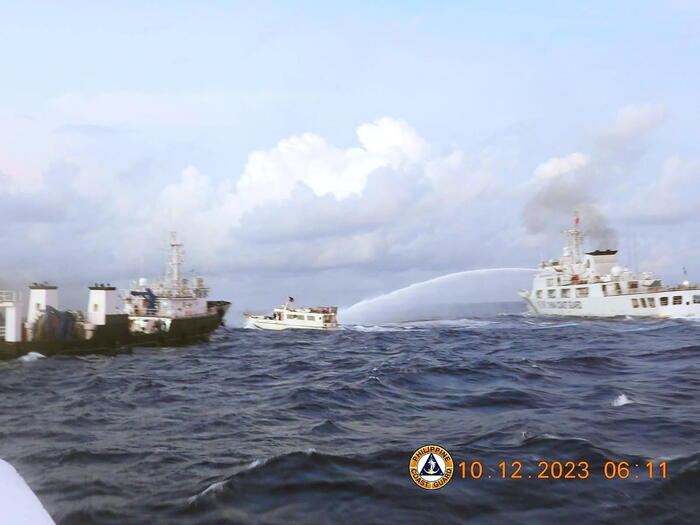Icon: enlarge
View of the North Sea on the Norfolk coast
Photo: David Tipling / Education Images / Universal Images Group / Getty Images
More than ten thousand years ago, it would not have been so easy for the British to split off from Europe, at least from a geographical point of view.
Back then, at the end of the last Ice Age, there were vast land masses where the North Sea is today.
They connected Great Britain with continental Europe and Scandinavia, where the last glaciers of the cold age had retreated.
You could basically go to England on foot.
One only had to cross a huge river system, it had its bed in the English Channel and was fed by the Rhine, Seine and Thames as tributaries.
For the people of the Stone Age, this Doggerland was an attractive settlement area.
They moved north and some stayed in the region between Denmark and the British east coast, somewhere in the 25,000 square kilometer area.
Icon: enlarge
This map shows the Storegga event and places where traces of it were found
Photo: M. Muru / Cambridge University Press / Antiquity Publications
There was game in the woods and fish in lakes and rivers.
But people were in the middle of an adjustment process.
Instead of hunting the herd animals of the Paleolithic, they now learned to hunt down individual prey and catch fish.
Time and again, prehistoric tools or bones of land animals from today's North Sea came to light.
But as the ice masses melted, the sea level rose, in some cases up to a meter per century.
The Doggerland was flooded and a central area around the Doggerbank became the island.
A good 8,000 years ago, life in the island paradise was suddenly over - at least that's what researchers thought for a long time.
At least one tsunami swept across the sea and coasts.
Triggered by gigantic, submarine landslides off the coast of Norway in the North Atlantic.
Around the North Sea, geologists found traces of this catastrophe, the so-called Storegga event, sometimes far inland.
The largest tidal wave reached heights of up to 20 meters on the Shetland Islands.
Researchers have come to a surprising finding in extensive investigations.
Doggerland may not have completely disappeared, believes a team led by archaeologist Vincent Gaffney from the University of Bradford.
A small island archipelago could have survived the masses of water and defied the North Sea for a long time.
And maybe the islands were a retreat for the settlers of that time.
"The previous conception of the catastrophic event may need to be reconsidered," writes Gaffney in the specialist magazine "Antiquity".
Icon: enlarge
Temporal reconstruction of the coastline with the Doggerland and the Doggerbank
Photo: M. Muru / Cambridge University Press / Antiquity Publications
In the study, the scientists present possibilities to geologically and archaeologically investigate disasters such as the Storegga event and to reconstruct the history of the Doggerland.
To do this, they worked from ships for years and mapped the sea floor using sound waves.
They gained important knowledge from drill cores through which they were able to obtain a cross-section of the sediments.
There the team found the genome of animals and plants that lived on Doggerland, they report in a second study that was published in the journal »Geosciences«.
Sediment examinations had already revealed astonishing things.
Mosses had survived the mass extinction in excellent condition, as they were superbly preserved by the sea mud.
A few years ago, researchers were even able to find out when the tsunamis swept across Doggerland.
An interesting picture emerges from the traces in the sediments.
Accordingly, only the northern part of the island was flooded - from there the water spread.
But some hills and also the vegetation could have softened the force of the largest wave, which is why not all of the land disappeared.
Many people and animals certainly fell victim to the disaster.
But part of the island could stand.
Because above the layers of the Storegga landslide, which can also be seen in the sedimentation, the scientists found evidence of plants and animals again.
So there must have been life on Doggerland, at least for a few more centuries.
Archaeological evidence is missing
However, it cannot be said whether people survived the tsunami.
The analysis of the drill cores gives no information about this.
And the researchers cannot dig for traces of settlement either.
To do this, they would not only have to dive to the bottom of the North Sea, but also look deeper into the sea floor.
However, in their investigations, based on the surface profiles, they indicate a few settlement sites that would have been well suited.
Life would have been much more difficult for the Doggerland region after the catastrophe.
Because the sea water had made the soil too salty and left barren swampy landscapes behind.
And around 5500 BC
Christ was all over anyway.
At that time, the sea took the last few meters of the archipelago in the North Sea.
Icon: The mirror
joe






